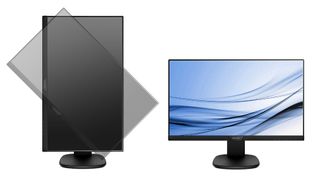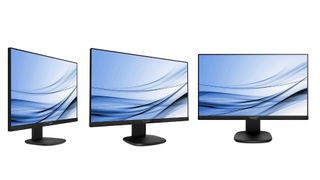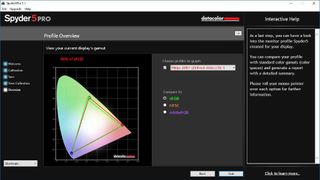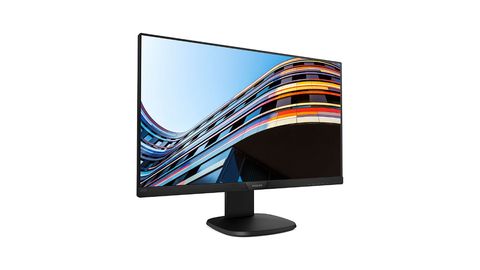TechRadar Verdict
A low-cost display doesn’t need to feel cheaply made, or compromise on style or features – and the S-Line 243S7EHMB proves it.
Pros
- +
Affordable
- +
Power efficient
- +
Good ergonomics
Cons
- -
Encourages VGA use
- -
Contrast range could be better
Why you can trust TechRadar
Monitors aimed at business users might seem a rather quaint prospect to gamers or graphics professionals, but the range of available products demonstrates the underlying strength of this sector.
Business users are usually looking for effective no-frills solutions that will work with older systems, require little or no tweaking for optimal performance, and are unerringly straightforward.
Many of those points are addressed by the new Philip’s S-Line series, and specifically, the S-Line 243S7EHMB reviewed here.

Price and availability
Initially, the S-Line 243S7EHMB will be available in Europe, priced at just £159 in the UK. It’s expected to arrive in the US market this coming August with a price tag of $199 (about AU$265).
That cost brackets it between the cheaper BenQ BL2405HT and the pricier LG 24MB35PH.
Here is the Philips S-Line 243S7EHMB configuration sent to TechRadar Pro for review:
Screen size: 23.8-inches
Native resolution: 1920 x 1080
Aspect ratio: 16:9
Refresh rate vertically: 56-76Hz
Pixel density: 93 ppi
Response time (typical): 5ms (GtG)
Viewing angle: 178-degrees horizontal/vertical
Brightness: 250cd/m2
Static contrast ratio: 1000:1
Ports: HDMI 1.4, VGA, PC audio in, Headphone out
Built-in speakers: 2W x 2
Dimensions (including stand): 540 x 483 x 202mm
Weight (including stand): 5kg
Built for business
This is a 23.8-inch Full HD (1920 x 1080) IPS panel with HDMI and VGA inputs that should work with any PC that’s been sold in the last 20 years or more.
The IPS display technology delivers punchy colours and great viewing angles, and Philips also affixed a textured panel coating to minimise reflection from natural light sources.
Included in the modest cost is a robust support stand that allows for 13cm of vertical height adjustment, -5/20 degrees of tilt and 90 degrees of rotation.
Considering the price, having a stand with rotation was an unexpected pleasure, and might encourage more users to entertain portrait mode for web or document work.
Our only reservation about the stand is that if you tighten the provided VESA screws fully when assembling, it won’t rotate. To get this feature back the screws need to be loosened a little, creating the needed clearances.
The support arm alone ticks many ergonomic boxes, but Philips didn’t stop there in making the S-Line attractive to companies nervous at the ballooning cost of liability insurance.
The company has included its Flicker-free and EasyRead technologies into these displays, along with a LowBlue mode that negates the harmful frequencies in the blue spectrum without appreciably impacting on colour representation.
Given its importance as a selling point, the fact that the LowBlue mode isn’t active by default makes for a rather curious decision.
Another lure for business customers is the running cost, which compared with any CRT they’re still using is remarkably frugal. Philips quotes 14.6W under Energy Star 7.0 testing methods, and just 11W in Eco mode.
At just 5kg including the stand this unit is also relatively easy to move around, a godsend for a busy IT department deploying many screens (or deploying to remote locations).

Performance
As this isn’t a professional screen designed for accurate colour reproduction we weren’t expecting much from our display analysis, but the 243S7EHMB is way better than many business-oriented displays.
The sRGB range is a decent 96% and it even manages 76% of the tougher AdobeRGB spectrum. A weakness here is the contrast range, which doesn’t approach the 1000:1 static ratio quoted – our testing found it to be 370:1.
Default contrast levels are 50%, and pushing it to 100% reduced the potential contrast range even if the image appeared to have more distinction.
A contributory factor to that is certainly the backlight which appears to be strongly biased to the centre line, with the corners registering a 5% or more reduction in illumination.
As noticeable as that might sound, without using a sensor this wasn’t obvious, and the panel appeared consistent to the unaided eye.
The tone response curve is close to the default Gamma 2.2 though not exactly on that curve.

Testing revealed that the default temperature is around 6100k, and the menus allow you to choose from a selection of predefined values, or to use SRGB mode or define your custom RGB levels.
That these options are included in a product not specifically built for colour accuracy hints that, if anything, there are too many menu options in what ideally should be an inherently fire-and-forget solution.
The quoted power consumptions were accurate, with the unit consuming about 16.9W with brightness set at 100% (the default) and 12.4W at 50%. A properly calibrated panel generating around 120cd/m2 takes the 11W that Philips defines as Eco mode, although there is no selectable option to set that in the menu structure.
Mark is an expert on 3D printers, drones and phones. He also covers storage, including SSDs, NAS drives and portable hard drives. He started writing in 1986 and has contributed to MicroMart, PC Format, 3D World, among others.

